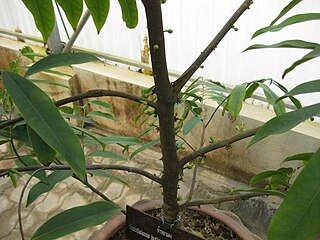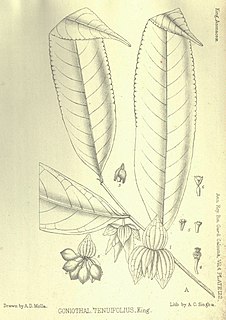Goniothalamus aurantiacus is a species of plant in the family Annonaceae. It is native to Thailand. Piya Chalermglin and Richard M.K. Saunders, the botanists who first formally described the species, named it after its orange colored inner petals.
Goniothalamus chartaceus is a species of plant in the family Annonaceae. It is native to Vietnam. Hui-lin Li, the Chinese botanist who first formally described the species, named it after its papery leaves.
Goniothalamus expansus is a species of plant in the family Annonaceae. It is native to Thailand and Vietnam. William Grant Craib, the British botanist who first formally described the species, named it after its exanded stigmas.

Goniothalamus laoticus is a species of plant in the family Annonaceae. It is native to Laos and Thailand. It was originally described by the French botanists Achille Eugène Finet and François Gagnepain using the basionym Mitrephora laotica. In Thailand it is commonly called Khao Lam-dong and is used as a traditional medicine.
Goniothalamus latestigma is a species of plant in the family Annonaceae. It is native to Myanmar and Thailand. Cecil Ernest Claude Fischer, the botanist who first formally described the species, named it after its broad stigmas.
Goniothalamus maewongensis is a species of plant in the family Annonaceae. It is native to Thailand. Richard M.K. Saunders and Piya Chalermglin, who first formally described the species, named it after the Mae Wong National Park in Thailand where the type specimen was collected.
Goniothalamus nitidus is a species of plant in the family Annonaceae. It is native to Borneo. Elmer Drew Merrill, the American botanist who first formally described the species, named it after its shining leaves.

Goniothalamus ridleyi is a species of plant in the family Annonaceae. It is native to Borneo, Peninsular Malaysia, Sumatra and Thailand. George King, who first formally described the species, named it after the English botanist Henry Nicholas Ridley who collected the specimen King examined.
Goniothalamus rotundisepalus is a species of plant in the family Annonaceae. It is native to Peninsular Malaysia and Thailand. Murray Ross Henderson, the Scottish botanist who first formally described the species, named it after its sepals which are rounded like the arc of a circle.
Goniothalamus rongklanus is a species of plant in the family Annonaceae. It is native to Thailand. Richard Saunders and Piya Chalermglin first formally described the species and named it after Phu Hin Rong Kla National Park in Thailand.

Goniothalamus scortechinii is a species of plant in the family Annonaceae. It is native to Peninsular Malaysia and Thailand. George King, the British botanist who first formally described the species, named it in honor of Benedetto Scortechini, an Italian priest and member of the Linnean Society of London and New South Wales who collected many important botanical samples in Peninsular Malaysia.
Goniothalamus tavoyensis is a species of plant in the family Annonaceae. It is native to Myanmar and Thailand. Debabarta Chatterjee, who first formally described the species, named it after a town in Myanmar that at the time was called Tavoy, but has since be renamed Dawei.

Goniothalamus tenuifolius is a species of plant in the family Annonaceae. It is native to Peninsular Malaysia, Thailand and Vietnam. George King, the British botanist who first formally described the species, named it after its slender leaved foliage.
Goniothalamus tortilipetalus is a species of plant in the family Annonaceae. It is native to Peninsular Malaysia and Thailand. Murray Ross Henderson, the Scottish botanist who first formally described the species, named it after its twisted petals.
Goniothalamus velutinus is a species of plant in the family Annonaceae. It is native to Borneo. Herbert Airy Shaw, the English botanist who first formally described the species, named it after the dense velvety hair on its branchlets and petioles.
Huberantha flava is a species of plant in the family Annonaceae. It is native to The Philippines. Elmer Drew Merrill the American botanist who first formally described the species, using the basionym Polyalthia flava, named it after its brilliant yellow flowers.
Mitrephora alba is a species of plant in the family Annonaceae. It is native to Peninsular Malaysia. Henry Nicholas Ridley, the English botanist who first formally described the species, named it after its white flowers.
Mitrephora macclurei is a species of plant in the family Annonaceae. It is native to China, Laos and Vietnam. Aruna Weerasooriya and Richard Saunders, the botanists who first formally described the species, named it after Floyd Alonzo McClure of Lingnan University, who collected the holotype specimen that they examined.
Mitrephora macrocarpa is a species of plant in the family Annonaceae. It is native to Sulawesi. Friedrich Anton Wilhelm Miquel, the Dutch botanist who first formally described the species using the basionym Orophea macrocarpa, named it after its large fruit.
Duckeanthus is a genus of plant in the family Annonaceae. It is native to Brazil. It contains a single species, Duckeanthus grandiflorus. Robert Elias Fries, the Swedish botanist who first formally described it, named it in honor of Adolpho Ducke who collected the specimen he examined, and its large flowers.



